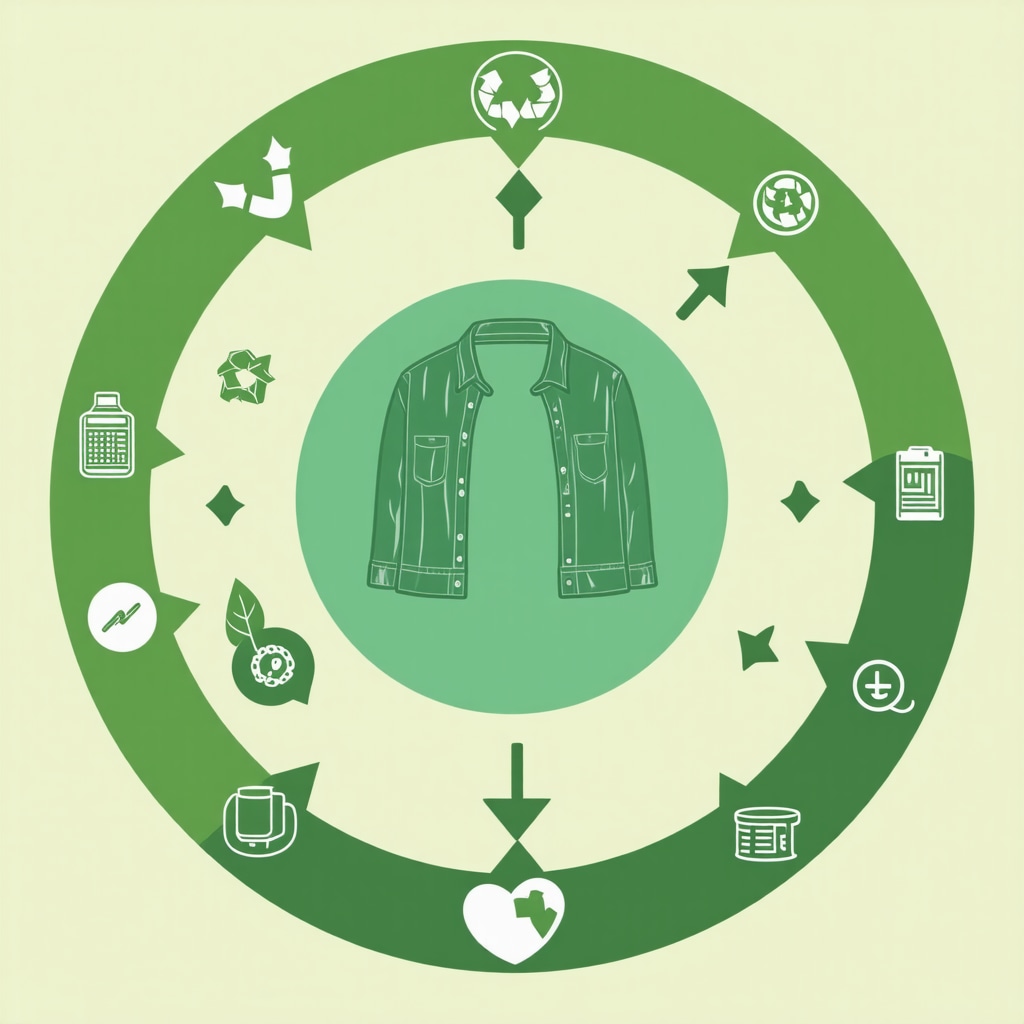Defining Green Garment Care: Beyond Conventional Cleaning Paradigms
Green garment care transcends traditional fabric cleaning by integrating environmentally sustainable methods that minimize chemical exposure and ecological footprint. It is a holistic approach encompassing the use of biodegradable solvents, energy-efficient technologies, and waste reduction strategies. As the textile industry grapples with pollution and toxic chemical usage, green garment care emerges as a pivotal solution for eco-conscious consumers and professionals alike, seeking to safeguard both fabric integrity and environmental health.
Innovative Solvents and Their Impact on Sustainable Fabric Maintenance
Central to green garment care is the adoption of plant-based and chemical-free solvents that replace hazardous substances such as perchloroethylene (perc). These alternatives, including silicone-based and liquid carbon dioxide solvents, offer effective stain removal and fabric preservation without compromising human health or contributing to air and water pollution. Research published in the Journal of Cleaner Production highlights the reduced environmental toxicity and improved biodegradability associated with these green solvents, underscoring their growing relevance in eco dry cleaning services.
Integrating Zero-Waste Principles: The Future of Eco-Friendly Dry Cleaning
Zero-waste dry cleaning, a subset of green garment care, emphasizes the complete elimination of landfill contributions and promotes the recycling of cleaning byproducts. This paradigm involves rigorous sorting, reusable garment bags, and solvent recovery systems that recycle and purify cleaning agents for repeated use. Such practices not only conserve resources but also align with circular economy principles pivotal to sustainable business models within the fabric care industry.
How Can Eco Cleaners Balance Fabric Longevity with Green Practices?
One of the nuanced challenges in green garment care is ensuring the longevity and aesthetic quality of delicate or luxury fabrics while employing sustainable methods. Eco cleaners must expertly calibrate solvent selection, cleaning cycles, and temperature controls to maintain fabric integrity. Specialized eco dry cleaning techniques tailored for sensitive materials, such as organic stain removal and hypoallergenic solutions, exemplify this balance. For instance, services detailed in Specialty Eco Garment Cleaning provide insight into maintaining high-end fabric care standards within green frameworks.
Advancing Consumer Awareness and Industry Standards in Green Garment Care
Consumer demand for transparency and eco-labeled garment care has catalyzed the emergence of green certification programs, fostering trust and credibility in eco dry cleaning providers. These certifications verify adherence to environmental regulations and sustainable operational practices, empowering consumers to make informed choices. Moreover, educational initiatives and expert forums facilitate knowledge sharing, driving continuous innovation and adoption of best practices across the industry.
For professionals eager to deepen expertise and contribute to the evolving landscape of sustainable fabric care, exploring related advanced topics such as plant-based and chemical-free solutions and zero-waste dry cleaning innovations offers valuable insights and practical applications.
Harnessing Technology for Precision in Eco Garment Care
As green garment care advances, the integration of cutting-edge technology becomes pivotal in optimizing both environmental impact and fabric preservation. Digital monitoring systems now allow dry cleaners to meticulously control solvent usage, temperature, and cycle duration, significantly reducing waste. Furthermore, AI-driven analytics enable predictive maintenance of equipment, ensuring consistent performance and minimizing unexpected resource consumption. These technological strides not only elevate the efficacy of eco-friendly cleaning methods but also align with sustainable operational goals.
Luxury Fabric Care Meets Sustainability: Challenges and Innovations
Caring for luxury fabrics sustainably demands a nuanced understanding of material science and eco-friendly practices. Fine silks, cashmeres, and delicate synthetics require solvents and processes that are gentle yet effective. Innovations such as bio-based enzymes and plant-derived surfactants are revolutionizing stain removal without harsh chemicals. Services like Luxury Green Dry Cleaning in Tampa exemplify how eco-conscious methods can maintain the elegance of high-end wardrobes while championing environmental stewardship.
What Role Does Consumer Behavior Play in Driving Sustainable Dry Cleaning Innovations?
Consumer preferences increasingly influence the trajectory of green garment care, compelling providers to innovate continuously. The demand for transparency, cruelty-free processes, and allergen-free cleaning solutions pushes the industry towards holistic sustainability. Understanding this dynamic allows businesses to tailor services that resonate with eco-aware clients, fostering loyalty and expanding market share. Moreover, educating consumers on the benefits of sustainable practices creates a feedback loop that accelerates adoption and encourages responsible garment care habits.
For those seeking to deepen their knowledge and stay abreast of the latest developments, exploring resources like the Green Certified Dry Cleaner Guide offers expert insights into selecting trusted eco-friendly providers.
Policy and Certification: Catalysts for Industry-wide Sustainable Transformation
Robust certification programs and environmental policies act as essential levers for embedding sustainability within the dry cleaning industry. Certifications such as Green Seal and OEKO-TEX ensure adherence to stringent ecological and health standards, thereby elevating consumer confidence and setting benchmarks for competitors. Policymakers are increasingly incentivizing green technologies through grants and regulatory frameworks that encourage the transition away from toxic solvents. The synergy between policy and industry standards fosters a resilient ecosystem for sustainable fabric care, prompting widespread adoption of eco-friendly innovations.
According to a 2023 report by the Environmental Protection Agency (EPA Safer Choice Program), certified green cleaning solutions significantly reduce hazardous waste and improve indoor air quality, underscoring the tangible benefits of regulated eco dry cleaning practices.
Engage with us by sharing your experiences or questions about sustainable garment care in the comments below, or explore further expert topics such as organic stain removal techniques for a deeper dive into eco-conscious fabric maintenance.
Cutting-Edge Biotechnologies Revolutionizing Eco-Friendly Fabric Treatment
Recent advances in biotechnology have ushered in a new era of sustainable fabric care, utilizing bio-catalysts and genetically engineered enzymes to target and degrade stubborn stains without environmental compromise. Unlike traditional chemical detergents that often contain phosphates and volatile organic compounds, these biological agents operate under mild conditions, significantly reducing water and energy consumption. For example, proteases and lipases derived from extremophilic microorganisms have demonstrated remarkable efficacy in breaking down protein- and lipid-based stains on delicate fibers while preserving fabric integrity.
Moreover, the integration of nanotechnology in eco garment care offers promising avenues for fabric protection and self-cleaning properties. Nanocoatings infused with hydrophobic and antimicrobial agents extend garment life and reduce the frequency of cleaning cycles, aligning with sustainability goals by minimizing resource use. These innovations are not only transformative in reducing ecological footprints but also elevate the performance standards of green dry cleaning services.
What Are the Challenges in Scaling Biotechnological Solutions for Commercial Eco Dry Cleaning?
While biotechnological advancements hold immense potential, their commercial scalability faces multifaceted challenges. Production costs of customized enzymes can be prohibitive, and maintaining enzyme stability under varying operational conditions requires sophisticated formulation. Additionally, regulatory hurdles concerning the use of genetically modified organisms (GMOs) in commercial products necessitate stringent compliance and consumer transparency. The delicate balance between innovation, safety, and market acceptance underscores the importance of interdisciplinary collaboration among microbiologists, chemical engineers, and industry stakeholders.
For those interested in exploring these frontiers, the Nature Reviews Chemistry article on enzyme engineering for sustainable applications offers an authoritative analysis of current breakthroughs and future trajectories.
Consumer Psychology and Behavioral Economics Driving Sustainable Fabric Care Adoption
The transition to green garment care is deeply influenced by consumer psychology and the principles of behavioral economics. Perceived value, environmental identity, and social norms play pivotal roles in shaping purchasing decisions related to eco dry cleaning. Studies indicate that consumers are more likely to adopt sustainable services when provided with clear information about environmental benefits coupled with tangible incentives such as loyalty rewards or cost savings over time.
Moreover, the phenomenon of choice architecture can be leveraged by eco cleaners to nudge consumers toward greener options. For instance, prominently featuring eco-certified services as default choices or bundling sustainable garment care with complementary green lifestyle products enhances uptake. Transparency through digital platforms and traceability of cleaning processes further empower consumers to make informed decisions, fostering trust and long-term engagement.
How Can Green Dry Cleaners Effectively Educate and Engage Diverse Consumer Segments?
Effective consumer engagement necessitates tailored communication strategies that resonate with varied demographic and psychographic profiles. Millennials and Gen Z, for example, often seek authenticity and brand alignment with their values, responding well to storytelling and social proof via influencer partnerships. In contrast, older demographics may prioritize health and safety aspects, requiring detailed explanations of solvent safety and hypoallergenic benefits.
Engagement initiatives such as interactive workshops, transparent labeling, and augmented reality demonstrations of eco cleaning processes can bridge knowledge gaps and enhance perceived service value. Data-driven segmentation and feedback loops also enable continuous improvement in messaging and service delivery.
Professionals aiming to refine their consumer engagement approach might find the insights from the Journal of Consumer Research on sustainable consumption behaviors invaluable for crafting nuanced marketing strategies.
Collaborative Ecosystems: Integrating Circular Economy Principles in Eco Garment Care Networks
Embracing a circular economy model in sustainable garment care entails collaborative networks among textile producers, dry cleaners, recyclers, and consumers to maximize resource efficiency and minimize waste. Closed-loop systems facilitate the recovery and reuse of solvents, packaging materials, and even textile fibers, fostering resilience and reducing environmental burdens.
Technological enablers such as blockchain provide transparent supply chain tracking, ensuring accountability and certification integrity across stakeholders. This transparency not only enhances consumer confidence but also incentivizes compliance and innovation within the network. Partnerships with local governments and sustainability organizations further amplify impact through shared infrastructure and policy support.
To visualize this complex interplay, consider the integration of solvent recovery units paired with digital monitoring platforms that track solvent lifecycle from application to recycling, optimizing operational parameters and reducing emissions.

What Metrics Best Capture the Environmental and Economic Benefits of Circular Garment Care Systems?
Quantifying the success of circular garment care systems requires multi-dimensional metrics encompassing environmental, economic, and social parameters. Key performance indicators include solvent recovery rates, water and energy savings, reduction in greenhouse gas emissions, and waste diversion percentages. Additionally, economic assessments focus on cost savings from resource reuse, revenue generated from recycled materials, and job creation within green sectors.
Social impact metrics evaluate consumer satisfaction, community engagement, and workforce health and safety improvements. Integrating these metrics within a comprehensive sustainability reporting framework enables stakeholders to benchmark progress, identify improvement areas, and communicate achievements transparently.
Experts and practitioners are encouraged to explore advanced lifecycle assessment tools and sustainability standards such as ISO 14040 series to deepen their analytical capabilities and optimize system design.
Biotechnological Frontiers: Enzymatic and Nanotechnological Enhancements in Eco-Friendly Cleaning
The advent of biotechnological innovations has introduced sophisticated enzymatic formulations and nanotechnologies that elevate green garment care beyond conventional limits. Engineered proteases and lipases derived from extremophiles catalyze precise degradation of proteinaceous and lipid stains under mild environmental conditions, drastically lowering energy consumption and chemical runoff. Concurrently, nanocoatings imbued with antimicrobial and hydrophobic properties bestow fabrics with self-cleaning capabilities and extended durability, effectively reducing cleaning frequency and resource usage. These advancements signal a paradigm shift towards bio-inspired, high-performance fabric maintenance strategies.
Strategizing Consumer Engagement: Behavioral Economics Meets Sustainable Garment Care
Adoption of sustainable dry cleaning practices hinges on nuanced understanding of consumer psychology and behavioral economics. Leveraging principles such as choice architecture and social norm activation enables eco cleaners to nudge diverse consumer segments towards greener alternatives. Tailored communication strategies—ranging from authenticity-driven storytelling targeting younger demographics to health-centric messaging appealing to older cohorts—enhance engagement and loyalty. Augmented reality demonstrations and interactive educational workshops further bridge knowledge gaps, fostering informed decision-making and sustained behavioral change.
How Can Data-Driven Metrics Optimize Circular Economy Implementation in Eco Garment Care?
Effective deployment of circular economy principles in garment care necessitates rigorous multi-dimensional metrics to quantify environmental, economic, and social outcomes. Solvent recovery efficiency, energy and water conservation rates, and greenhouse gas emission reductions constitute critical environmental indicators. Economic metrics encompass cost savings from resource reutilization and revenue streams from recycled materials, while social metrics assess workforce health, consumer satisfaction, and community engagement. Integrating these indicators within frameworks such as the ISO 14040 lifecycle assessment standard facilitates continuous system optimization and transparent stakeholder reporting.
Policy Synergies and Certification: Driving Industry-Wide Sustainable Transformation
Robust policy frameworks and authoritative certifications like Green Seal and OEKO-TEX catalyze the widespread adoption of sustainable garment care practices. Regulatory incentives, including grants and tax credits for green technology deployment, complement these standards, fostering a resilient ecosystem that prioritizes environmental stewardship and consumer safety. The EPA Safer Choice Program exemplifies governmental efforts to endorse vetted eco-friendly cleaning solutions, enhancing market trust and driving innovation.
Collaborative Innovations: Blockchain and Digital Monitoring in Circular Garment Care Networks
Emerging collaborative ecosystems integrate blockchain technology and advanced digital monitoring to augment transparency and operational efficiency within circular garment care frameworks. Blockchain ensures immutable traceability of solvents and materials, confirming compliance across the supply chain. Simultaneously, IoT-enabled sensors and AI analytics optimize solvent lifecycle management and energy consumption, reducing emissions and operational costs. These synergistic technologies empower stakeholders to co-create sustainable value chains, reinforcing accountability and accelerating green innovation adoption.

For industry professionals and researchers eager to harness these advanced insights and technologies, engaging with interdisciplinary knowledge platforms and certification bodies is paramount. Explore resources such as the Nature Reviews Chemistry article on enzyme engineering for sustainable applications and participate in forums dedicated to green fabric care innovations.
Join the conversation: Share your experiences or inquiries about implementing cutting-edge sustainable garment care practices in the comments below and connect with a community advancing eco-conscious textile stewardship.
Expert Insights & Advanced Considerations
Strategic Integration of Biotechnological Innovations in Sustainable Fabric Care
Emerging enzyme engineering and nanotechnology applications represent a frontier for eco garment care, enabling stain degradation and fabric protection with minimal environmental impact. However, successful integration demands interdisciplinary collaboration to overcome scalability and regulatory challenges, ensuring these solutions are both effective and market-viable.
Leveraging Behavioral Economics to Accelerate Consumer Adoption of Green Dry Cleaning
Understanding the nuanced drivers of consumer behavior—such as social norms, perceived value, and choice architecture—allows eco cleaners to craft tailored engagement strategies. These approaches not only foster loyalty but also normalize sustainable garment care practices across diverse demographics.
Optimizing Circular Economy Metrics for Holistic Evaluation of Eco Garment Care Systems
Robust, multi-dimensional sustainability metrics that capture environmental, economic, and social impacts are essential for validating and refining circular garment care models. Adopting international standards like ISO 14040 facilitates transparent reporting and continuous improvement across stakeholders.
Policy and Certification as Dynamic Catalysts for Industry Transformation
Progressive environmental policies and stringent certification frameworks create a compelling ecosystem that incentivizes green technology adoption and assures consumers of service integrity. This synergy accelerates the transition toward a more sustainable and responsible garment care industry.
Harnessing Blockchain and Digital Technologies to Enhance Transparency and Efficiency
Integrating blockchain for immutable supply chain traceability with AI-driven digital monitoring optimizes solvent lifecycle and resource utilization. These technologies empower stakeholders with actionable data, reinforcing accountability and fostering innovation in sustainable fabric care.
Curated Expert Resources
- Nature Reviews Chemistry: Enzyme Engineering for Sustainable Applications – A comprehensive analysis of biotechnological innovations shaping eco fabric care, essential for understanding enzyme-based cleaning advancements. (Read here)
- EPA Safer Choice Program – Government-endorsed guidelines and certifications for green cleaning products, offering authoritative standards for eco dry cleaning safety and environmental impact. (Explore program details)
- ISO 14040 Lifecycle Assessment Standards – International framework for evaluating environmental impacts across product lifecycles, critical for measuring circular economy benefits in garment care.
- Journal of Cleaner Production – Peer-reviewed research on sustainable solvents and eco-friendly textile maintenance methods, providing data-driven insights for industry professionals. (Access articles)
- Journal of Consumer Research: Sustainable Consumption Behaviors – In-depth exploration of consumer psychology and behavioral economics principles applicable to green garment care marketing strategies. (Read study)
Final Expert Perspective
Green garment care is no longer a niche concept but a sophisticated, multi-faceted discipline intertwining innovative science, consumer psychology, and systemic sustainability frameworks. The convergence of biotechnological advances, behavioral economics, and robust policy frameworks creates an unprecedented opportunity to redefine fabric maintenance standards while honoring ecological imperatives. Industry leaders and eco-conscious consumers alike must engage deeply with these evolving paradigms to drive meaningful impact.
For those committed to advancing expertise and contributing to this transformative journey, exploring topics such as plant-based and chemical-free solutions and zero-waste dry cleaning innovations offers valuable pathways. Connect with us to share your professional insights, questions, or to discover trusted eco-friendly services like Green Certified Dry Cleaner options that exemplify excellence in sustainable garment care.


The holistic approach of green garment care really resonates with me, especially the emphasis on using biodegradable solvents and energy-efficient technologies. In my experience, some dry cleaners struggle to maintain a balance between being genuinely eco-friendly and ensuring the fabrics—especially delicate or luxury ones—come back looking pristine. The article’s mention of specialized eco dry cleaning techniques tailored for sensitive materials is particularly insightful because it acknowledges that sustainability doesn’t mean compromising on fabric care quality. I also appreciate how zero-waste principles are incorporated, like solvent recovery and reusable garment bags, which align well with the circular economy model that’s becoming crucial in many industries. However, I wonder how widespread the adoption of these advanced solvents and zero-waste systems really is—especially among smaller or local dry cleaners who might face budget constraints. Has anyone here found effective ways to support or encourage local cleaners to transition to greener methods without it becoming prohibitively expensive? It would be great to hear about practical strategies or experiences in bridging this gap between sustainable innovation and everyday accessibility.